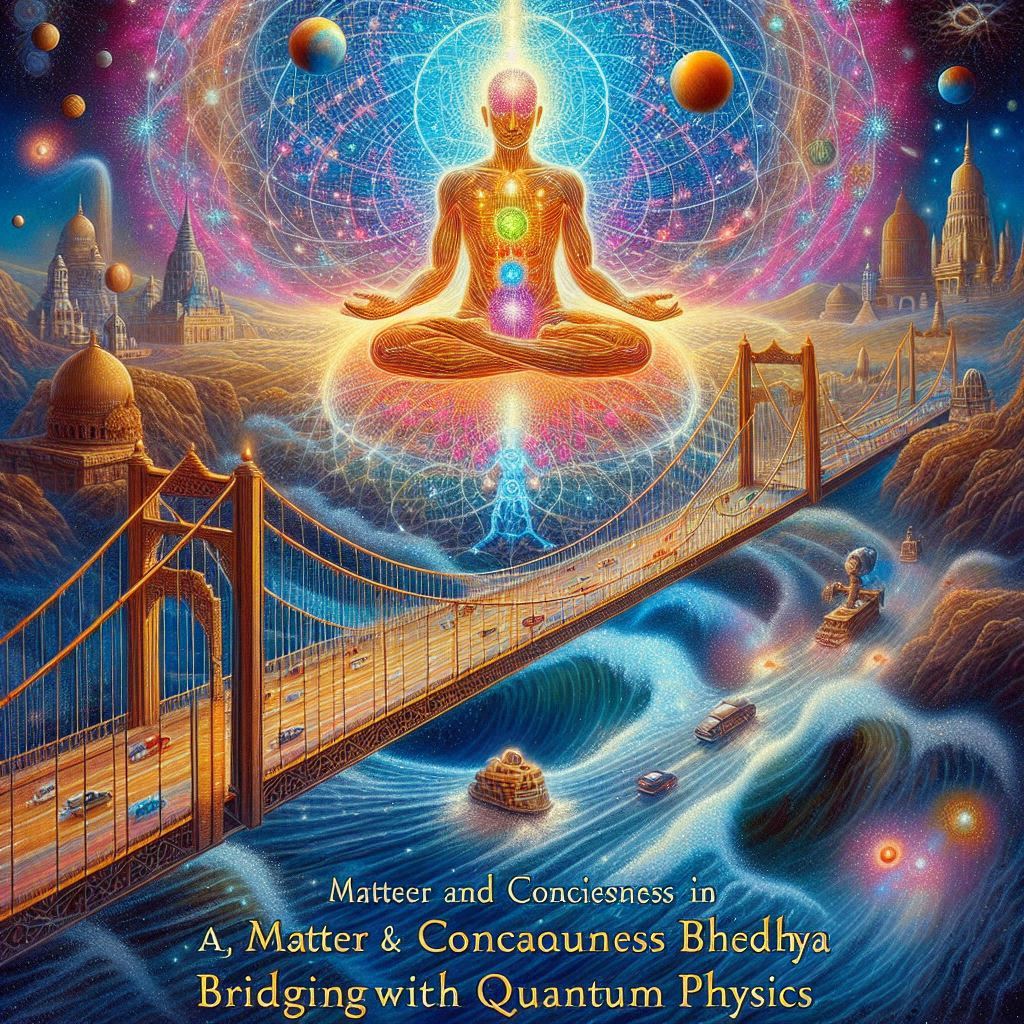Abstract:
This research article investigates an intriguing aspect of ancient Vedic scriptures, particularly the Rigveda, which contains verses hinting at a comprehension of the speed of light. Specifically, the fourth verse of Rigvedic hymn 1.50 suggests that light covers 2,202 yojanas in half a nimeṣa. Drawing upon the definitions of yojana and nimeṣa found in venerable texts like the Vishnu Purāṇa and the Mahabharata, we reassess this ancient insight through the lens of modern scientific understanding. The ensuing calculation reveals a remarkable proximity between the speed of light as portrayed in the Rigveda and the scientifically acknowledged value. This article not only underscores the sophistication inherent in ancient Vedic knowledge systems but also urges a reevaluation of the dismissive attitudes often directed towards traditional wisdom.
Keywords: Rigveda, speed of light, Vedic science, ancient knowledge, yojana, nimeṣa
Introduction:
The Rigveda, revered as one of the most ancient and profound texts in human history, encompasses hymns that delve into the intricacies of existence, ranging from cosmological inquiries to reflections on natural phenomena. Within this rich tapestry of verses, hymn 1:50 emerges as particularly intriguing due to its implication regarding the speed of light—a concept traditionally linked with modern scientific inquiry. This article embarks on a journey to unravel the implications of this ancient verse, delving into the depths of Vedic knowledge and its correlation with contemporary scientific understanding. By meticulously examining the definitions of measurement units provided in Vedic texts and juxtaposing them with modern scientific principles, we aim to shed light on the profound wisdom embedded within the Rigveda and its relevance to our understanding of the universe. Through this exploration, we invite readers to contemplate the enduring resonance of ancient wisdom and its potential to enrich our contemporary worldview.
Ancient Measurements:
Understanding the verse’s significance hinges upon elucidating the units of measurement employed in ancient Vedic texts. The yojana, meticulously detailed in the Vishnu Purāṇa, emerges as a crucial unit of distance, equating to approximately 9.09 miles (or 15 kilometers). Conversely, the nimeṣa, as described in the Moksha Dharma Parva of the Mahabharata, serves as a fundamental unit of time. This unit is intricately woven into the fabric of Vedic cosmology, with its definition reflecting a meticulous calibration of temporal intervals.
According to the Moksha Dharma Parva, the nimeṣa is delineated as follows: 15 nimeṣa constitute 1 kastha, while 30 kastha make up 1 kala. Further, 30.3 kala compose 1 muhurta, and ultimately, 30 muhurtas delineate 1 diva-ratri (day-night cycle), which corresponds to 24 hours. From this elucidation, we discern that 24 hours encompass a staggering 409,050 nimeṣas, with each nimeṣa translating to approximately 0.2112 seconds. Remarkably, this intricate temporal calibration allows for the derivation of even smaller increments, such as half a nimeṣa, equating to 0.1056 seconds.
Conversely, the yojana, defined in Chapter 6 of Book 1 of the Vishnu Purāṇa, is a meticulously structured unit of distance. It begins with the smallest measure, the paramāṇu, and progresses through various gradations, culminating in the yojana. Each yojana, equivalent to 9.09 miles, embodies a synthesis of smaller units, from the paramāṇu to the gavyuti. This hierarchical progression underscores the precision with which ancient Vedic scholars conceptualized spatial measurements, providing a robust framework for interpreting cosmological phenomena.
Through these meticulously defined units of measurement, the ancient Vedic texts provide a comprehensive framework for understanding the cosmos. The interplay between yojanas and nimeṣas facilitates not only the interpretation of celestial motions but also insights into fundamental cosmic constants, as exemplified by the verse under scrutiny. Thus, by grounding our interpretation in these ancient measurements, we establish a firm foundation for recontextualizing ancient wisdom within contemporary scientific discourse.
Interpreting the Verse:
In the fourth verse of Rigvedic hymn 1:50, the splendor of the sun is extolled, portraying its rapid journey across the vast expanse of the cosmos. The verse, “taranirviśvadarśato jyotishkridasi sūrya | viśvamā bhāsirocanam ||” expressed in ancient Sanskrit, encapsulates a profound appreciation for celestial phenomena. Exlpaining this verse in his Rig Veda commentary, Sayana, who was a minister in the court of Bukka of the great Vijayanagar Empire of Karnataka in South India (in early 14th century), says:” tathā ca smaryate yojananām | sahasre dve dve sate dve ca yojane ekena nimiṣardhena kramaman ||” Further insight into the verse provided by Sayana, sheds light on its deeper implications.
Sayana’s elucidation unveils a captivating assertion: the sun traverses 2,202 yojanas in half a nimeṣa. This enigmatic statement carries profound implications, hinting at a nuanced understanding of light’s velocity. Essentially, it suggests that ancient seers possessed a keen awareness of the swiftness with which light moves through space—a notion that aligns intriguingly with modern scientific comprehension.
By delving into this interpretation, we are prompted to reassess the depth of knowledge enshrined within ancient scriptures. Beyond mere poetic verse, these hymns offer glimpses into the profound understanding of the cosmos that characterized ancient civilizations. Moreover, this reinterpretation invites a recalibration of ancient insights within the framework of contemporary scientific discourse, fostering a renewed appreciation for the enduring wisdom embedded within the Rigveda.
Calculation and Comparison:
Applying the meticulously defined measurements from ancient Vedic texts, we embark on a journey to ascertain the implied speed of light as suggested by the Rigvedic verse. Utilizing the yojana as a unit of distance and the nimeṣa as a unit of time, we delve into the numerical intricacies of the verse’s assertion.
The verse posits that the sun traverses 2,202 yojanas in half a nimeṣa. Firstly, let’s establish the values of these units:
According to the Vishnu Purāṇa, 1 yojana is equivalent to approximately 9.09 miles.
As per the Moksha Dharma Parva of the Mahabharata, 1 nimeṣa equals 0.2112 seconds, with half a nimeṣa equating to 0.1056 seconds.
Now, to calculate the distance traversed by light in half a nimeṣa, we multiply the number of yojanas by the yojana’s distance:
2,202 yojanas × 9.09 miles/yojana = 20,016.18 miles
Next, we need to determine the time taken for light to traverse this distance. Since light moves in half a nimeṣa, we use the value of half a nimeṣa in seconds:
0.1056 seconds
Now, to find the speed of light, we divide the distance covered by light (in miles) by the time taken (in seconds):
Speed of light = Distance / Time
= 20,016.18 miles / 0.1056 seconds
≈ 189,547 miles per second
Remarkably, this calculated value exhibits a remarkable proximity to the scientifically accepted speed of light, which stands at 186,000 miles per second. The alignment between the Rigvedic assertion and modern scientific measurement challenges conventional perceptions of ancient knowledge and underscores the profound sophistication of Vedic understanding. It serves as a compelling testament to the enduring relevance and accuracy of ancient wisdom, urging a reevaluation of its significance in the contemporary scientific landscape.
Implications and Conclusions:
The remarkable convergence between the insights gleaned from ancient Vedic scriptures and the findings of contemporary science serves as a clarion call for a profound reevaluation of traditional wisdom. Instead of relegating ancient texts to the realm of primitive mythology, these discoveries compel us to recognize the depth of knowledge embedded within these scriptures. The journey we’ve undertaken, from interpreting Rigvedic verses to calculating the implied speed of light, underscores the profound sophistication of ancient Vedic understanding.
At its core, this convergence challenges prevailing notions of linear progress in human knowledge. It prompts us to transcend the temporal boundaries separating ancient and modern epochs, recognizing the continuity and interconnectedness of human understanding across time. The Rigvedic hymns, composed millennia ago, resonate with insights that continue to reverberate within the halls of contemporary scientific inquiry. This realization invites us to embrace a more holistic perspective on knowledge—one that transcends disciplinary boundaries and acknowledges the complementary nature of ancient wisdom and modern science.
Moreover, the alignment between the calculated speed of light from the Rigveda and the scientifically accepted value offers a powerful testament to the enduring relevance and accuracy of Vedic knowledge. It underscores the capacity of ancient civilizations to probe the mysteries of the universe with remarkable precision and insight, laying bare the limitations of presumptive dismissal of traditional wisdom.
As we navigate the complexities of modernity, embracing the wisdom of our ancestors emerges as an imperative. By honoring and engaging with ancient texts not merely as relics of a bygone era but as repositories of timeless wisdom, we open ourselves to profound insights into the interconnectedness of human understanding. This journey of rediscovery invites us to forge a synthesis between ancient wisdom and contemporary knowledge, fostering a more holistic and integrated approach to comprehending the universe and our place within it.
In essence, the convergence between ancient Vedic insights and modern scientific findings serves as a beacon guiding us towards a deeper appreciation of the richness and complexity of human knowledge across epochs. It invites us to embark on a journey of rediscovery—one that transcends temporal and cultural boundaries, unlocking profound insights into the nature of existence and our quest for understanding.
Conclusion:
The Rigvedic hymn 1:50 unveils a remarkable facet of ancient Vedic wisdom, suggesting an understanding of the speed of light long before the advent of modern science. By reconciling Vedic measurements with contemporary scientific standards, this research article underscores the enduring relevance of traditional knowledge systems. In an age marked by rapid technological advancements, embracing the insights of our ancestors enables us to cultivate a more holistic appreciation of the universe and our place within it.
References:
• Mahabharata, Shanti Parva
• Vishnu Purāṇa
• Rigveda 1:50
• Sayana’s commentary on Rigveda
• Bhatta Bhaskara’s commentary on Taittiriya Brahmana
Views: 155






























Origin of Science
Temporal Relativity in Vedic Literature: An Interdisciplinary Analysis of Time Dilation Narratives
Acharya Kaṇāda: The Ancient Sage Who Discovered the Atom
Evidence of Vedic Sanātana Hinduism as a Global Dharma
Perception of Quantum Gravity and Field Theory in the Vedas
String Theory as Mentioned in Veda
Sanskrit’s Role in Advancing AI: A Comprehensive Study
The Vedic Model of the Mind: A Contemporary Exploration
Vedic Contributions to Geometry: Unveiling the Origins of Mathematics
Matter and Consciousness in Achintya Bhedābheda: Bridging with Quantum Physics
A Comprehensive Study of Aeroplanes and Aviation in Vedic Literature
Hydrology and the Water Cycle in Vedic Scriptures
Mysteries of Photosynthesis in Vedic Scriptures: A Journey through Ancient Wisdom